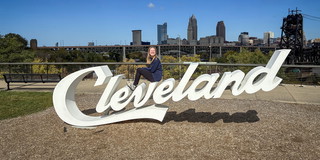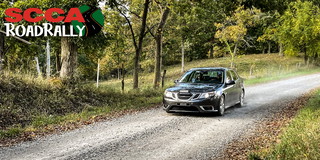
In November 2024 over the Veterans Day weekend, SCCA’s Cal Club Region and its RoadRally arm, the Santa Monica Sports Car Club, hosted the 29th United States RoadRally Challenge® (USRRC). The weekend marked both the fourth time Cal Club has hosted the USRRC, as well as the 20th anniversary of its first USRRC in 2004, which was headquartered in Santa Maria, CA.
Following 2004, Cal Club hosted USRRCs in 2011 and 2015 also, with headquarters both years in Valencia, CA. This year organizers Joe Akerman, event chair and rallymaster for Thunder Road, Larry Scholnick, rallymaster for Stagecoach, and Jeanne English, Highway Robbery’s rallymaster, opted for Lancaster, CA., which gave them access not only to the canyon roads of Los Angeles County, but also to the high-desert vistas of neighboring Kern County.
Because of their experience as USRRC hosts, both this year and in the past, we sat down with them after the event to talk about the “back office stuff,” the organizational end of a USRRC weekend that few competitors see.
Essentials You Need to Know
We began with a simple question: What has changed in the 20 years since Cal Club first hosted the USRRC?
“We have to pick out roads more carefully,” English said. “We want to stay out of the busy stuff unless it’s lunchtime or something like that. Other than that, we want to get out. So to write rallies, we’re doing more driving than we might have done years ago.”
That observation is reinforced whenever she looks at past rallies, English added. “I still have some of my old Highway Robberies, and occasionally I look at them. ‘Can I use any of this?’ I ask myself. ‘Nope – and nope and nope.’ What used to be a wide-open road now has a dozen traffic lights. So, it’s watching for that kind of stuff that’s important when you’re writing a rally.”
For 2024, it also meant that, for English, the trip from her home in Hawthorne, CA, to rally HQ in Lancaster was some 80 miles and two hours. For her colleagues, the trip was somewhat less but still, normally, an hour or more before actual work could begin on the individual rallies. Still, whether two hours or one, such distances tend to make long reconnaissance and setup days even longer – and when you make the trip five or six times, it gets expensive.

(Events like the 2024 USRRC span great distances, adding complications to the process if the rallymaster doesn't live nearby. Photo by Philip Royle)
“We decided a year ago to write a triple event. We picked this start location , and we each took a direction.” Scholnick explained. “Jeanne went south and west, Joe took north and west, and I took north and east.”
Scholnick, a member of SCCA’s RoadRally Board, recalled he was introduced to rallying in high school. “In 1969, one of my cohorts found an ad for a free gimmick rally, and several hundred cars showed up to run the rally in the San Fernando Valley. I was hooked. Back then there was a gimmick rally every weekend, sometimes twice, and sometimes even on Friday, and I ran most of them.”
For both Akerman and English, their introductions to rallying were similar. All three have long histories with the sport. All three also are veteran organizers.
“My goal [for the 2024 USRRC] was to have a brisk rally that had a lot going on,” Akerman said. “To take people through a variety of terrains and environments. I think I did pretty good on that, but I should have finished a little earlier and avoided sunset and the disappearance of good light.
“, I like that we went into the real California desert. It’s not just a flat thing. It’s got hills, where you can see for 20 miles. It’s got abandoned mines, towns that dried up and are long gone, and if you’re looking around, lots of interesting things. I thought Larry did a really good job,” Akerman said.
Based on her experience over the years with Highway Robbery, English said her advice to potential USRRC committees is straightforward: “Start early, and don’t get sick, like I did.” Also, she added, keep the lines of communication open with whomever in your Region has chief responsibility for the Region and its activities. Hosting a USRRC requires not only Region buy-in but also, sometimes, help with initial expenses, even if those expenses pale in comparison to other Region activities. While that help may have been forthcoming in the past, it might not be available now. “Know where you stand so you can plan accordingly and move forward,” English said.

(Pre-running a RoadRally that's located in a remote location can become expensive. Being sure to tackle those logistics will help out in the long run. Photo by Philip Royle)
Also, in the realm of event planning, English noted the advent of GPS timing and scoring has introduced a major, positive element compared to past USRRC weekends. “We don’t have to worry about whether we have enough workers. Our supply of workers had been dwindling for years, and this has been a big help in allowing us to continue. It has also speeded up scoring, but to me the worker situation is by far the biggest benefit.”
Scholnick agrees, and in discussing planning, he offered this advice to future USRRC rallymasters. “It takes several years and a concerted effort of running the type of rally you want to put on. Once you’ve been on a bunch, you should have an idea of what you like and don’t like and how to replicate what you like in your own event.”
A Chairman’s Advice
We also asked Akerman, a retired location manager for the film, TV, and advertising industry, what advice he, as event chair, would offer future USRRC committees. This is what he recommended.
Essential committee size. While Akerman, Scholnick, and English constituted the entire 2024 USRRC committee – and BTW, they did a stellar job – maybe six would be a good committee number, Akerman said: Event chair; three rallymasters; a promotions, social media, and website manager; and a “paperwork czar,” someone to handle sanctions, registration, waivers, weekend memberships, and scoring, including all post-event filings.
“Some of these jobs can overlap,” Akerman added, but define your roles. Be clear about who will be doing what. Remember, too, he said, you will need additional people for Safety Steward prechecks and rally prechecks, and if possible, event hospitality.
Get started early (at least six months before) and stay on top of things with regular – at least monthly – meetings, either zoom or in person, Akerman recommended. “Establish a timeline for the work to be done. Set target dates for your rally checkouts so the rallymasters have something to aim for.”
Lock in your date and location. “If your application had only a general location and a general date, tighten those up,” he said. Pick the exact dates first. “You’ll probably want a three-day weekend,” he advised.
Lock in your headquarters. “Find a hotel that can accommodate your dates and make a deal for a group room rate. You’ll want to have each room paid for individually by your entrants, and for them to have the ability to cancel without penalty if their plans change. The hotel should include a small meeting room – free if possible – for registration and pre-rally instruction distribution. Free breakfasts and free self-parking are a big plus also. Avoid having to pay for a block of rooms in advance. That’s a huge pitfall and a sure way to go broke. Do not do it. If the hotel insists, move to another hotel.”

(Finding unique locations for aRoadRally are important, but logistical obstacles for the event go well beyond that. Photo by Joe Akerman)
Find a theme and a name for your event. Create a logo and informational flyers. Get your MotorsportReg.com page(s) up ASAP. “Put all the information you can on the MSR listing: entry fees, links to the hotel deal, descriptions of the type and length of each rally, contact info for questions, etc. You want to get on the MSR first-of-the-month calendar email right away,” Akerman said.
Start your promo. “Start listing your event in as many places as you can as soon as you can. Get a website going if you don’t already have one. Update it often. Post the event on as many SCCA Facebook groups as you can. Find as many administrators of SCCA Region and SCCA-related Facebook pages as possible. Get those admins to post info about your event on their pages.”
Find a sponsor. “See if you can find a local, possibly rally-related, business to sponsor trophies, etc.,” Akerman said. “We had no luck this time, but we have been successful in the past. Also, ask your Region for help.”
Sad to say, Akerman added: “Rallymasters probably should expect to spend something approaching $1,000 each out of pocket for gas, food, and possibly lodging during the rally-writing process. Most rallymasters probably know this already, because it’s about the same for any National rally. Also, we each donated the cost of printing our routes and generals. We ended up having to spend almost all of the Santa Monica Sports Car Club’s existing funds (over $1,000) to make up the gap between entry fees and actual costs for trophies, hospitality, and hotel rooms for official checkouts and the rally weekend itself.”
Finally, and most important, Akerman said, “Be sure you are doing all this purely for the fun of it.”
For More Information
Find additional information about the USRRC on the RoadRally pages at scca.com. Also, check out Appendix J of RoadRally’s Rules for Organizers (RFOs, available as a PDF at scca.com) or query the RoadRally Board’s National Events Committee (nec@scca.com).
Main photo by Joe Akerman








